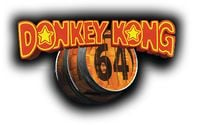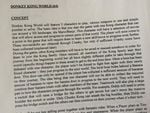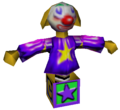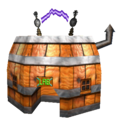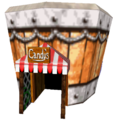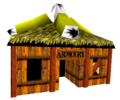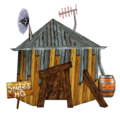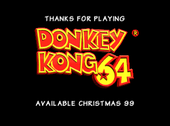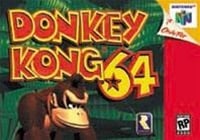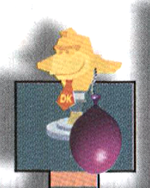List of Donkey Kong 64 pre-release and unused content
This is a list of pre-release and unused content for the game Donkey Kong 64.
Development timeline[edit]
- Late 1996-Early 1997: Development begins.
- c. Mid-1998: Work on the 2.5D version ends in favor of a 3D free-roaming approach.
- 1999:
- January: The game is officially announced with a screenshot in Nintendo Power.
- May 12: Nintendo announces that the Expansion Pak, now a requirement for running DK64, will come bundled with the game.
- May 13-15: A custom build is shown off at E3 1999.
- August: The E3 build makes a reappearance at Space World 99.
- September: An in-store demo is released.
- November 22: The final game is released.
Pre-release elements[edit]
Early ideas[edit]
- The game was named "Donkey Kong World" in its pitch document.[1] The document mentions the existence of "Cranky coins" used to purchase new moves and skills, a function served by Banana Bunch Coins in the final game.
- According to various issues of The 64 DREAM from 1998 to 2000, another early title for the game was "Ultra Donkey Kong". The title was changed to Donkey Kong 64 to make it clearer that it was a Nintendo 64 game and avoid confusion with the Donkey Kong Country television series, the Donkey Kong Card Game, and Donkey Kong Land III.[2]
Early builds[edit]
General[edit]
- Early in development, the developers were asked by management to use the Expansion Pak with Donkey Kong 64 and find ways to justify its usage in the game.[3]
- Early screenshots of Donkey Kong 64 showed that DK's Tree House originally had a fridge in it with images of Banjo and Kazooie on it, which would have been where Banjo-Kazooie's Ice Key would have been stored after obtaining it via Stop 'N' Swop.[4] Also, the boss Mad Jack was originally known as "Junk-in-the-Box" and was also drastically different in appearance. He was also originally a mini-boss fought by Tiny Kong[5] in the R&D Room in Frantic Factory instead of being a full boss fought at the area's end. The Toy Monster is the mini-boss in the final version, and it is fought by Chunky Kong.
- The weapons the Kongs wielded in earlier builds looked like real-world firearms instead of the wooded, cartoonish ones seen in the final version of the game.[6] Donkey Kong's Coconut Shooter resembled a double-barreled shotgun while Diddy Kong's Peanut Popguns resembled actual pistols, and reportedly shot bullets with realistic sound effects. The stylization to cartoonish weapons was soon suggested by Shigeru Miyamoto during a test build session by creative director George Andreas,[7] who indicated that it was initially a placeholder that he had simply gotten used to in development.[8]
- The developers came across a game breaking bug late in development which was exclusive to a specific revision of the Nintendo 64 console. This bug was later fixed.[3]
- Several enemies were dropped from the game, including a Re-Koil, an insect, an armadillo (possibly Army), and two variants of a Jack-in-the-Box like enemy, one as a clown and another with a boxing glove.
- Cranky's Lab, Candy's Music Shop, Funky's Store and Snide's HQ all looked slightly different in the pre-release version compared to the final version.
- By using the glitch to obtain the fifth Boss Key in Angry Aztec and then enter Troff and Scoff's room again, the player can see that the boss door has the DK logo with a green checkmark over it, indicating that the boss has been beaten.
- A golden Banana Bunch appears as the early HUD icon for the Golden Banana in the kiosk demo; it appears if players win Diddy Kong's Mine Cart mini-game. A single frame of the icon appears in the final game, as the emblem on B. Locker's head.
The Banjo and Kazooie fridge originally found in DK's Tree House in Donkey Kong 64
Junk-in-the-Box, what Mad Jack looked like before Donkey Kong 64 was fully completed
The unused armadillo enemy, resembling an Army
Unused model of a Re-Koil
Early model of Cranky's Lab
Early model of Candy's Music Shop
Early model of Funky's Store
Early model of Snide's HQ
Not For Resale demo cartridge[edit]
A demo cartridge was produced to exhibit the game in retail stores. It contains the second Dogadon fight, the Mine Cart-riding sequence in Jungle Japes and a boss fight with Army Dillo. This demo features a few differences from the final build.[9][10]
Text and interface[edit]
- Squawks dialogue after completing the Mine cart minigame is different and shorter.
Audio[edit]
- Dogadon has a different sound effect for his spitting attack. The sound effect is used by the Llama in the final version, when Donkey Kong wakes him up inside his temple to cool the pool of lava.
- The themes played after defeating the bosses are different from the final build. After defeating Dogadon, the boss theme continues to play after the key spawning jingle instead of playing the Troff 'n' Scoff theme like in the final game. When Army Dillo is defeated, the game stops the boss theme and plays the boss door opening fanfare the instant the final blow is dealt, then plays the theme heard immediately after opening a boss door when the key spawning jingle finishes.
- Army Dillo has a different voice and several fully acted lines cut from the final version.
Gameplay[edit]
- A counter for a silver Balloon item (which act as an extra life) appears to the left of the life counter. The balloon cannot be collected through the normal course of the demo, but it is present in a debug room left on the cartridge.[11]
- For the Mine cart minigame, the player has to collect 70 coins rather than 50 as in the final version.
- Though fought in Jungle Japes, Army Dillo has the same attack patterns as the Crystal Caves rematch in the final build.
Box art[edit]
- The game's original box art before being released depicted only Donkey Kong in a jungle background before being replaced with a group picture of all five Kongs riding on the minecart with King K. Rool in the background. However, the cartridge artwork still retains the original prototype box art.
Stop 'N' Swop[edit]
As with Banjo-Kazooie and four other unspecified Rareware-developed games,[12] Donkey Kong 64 had a planned "Stop 'N' Swop" function that allowed players to unlock exclusive in-game content by quickly swapping two compatible game cartridges while the Nintendo 64 system's power was on. The feature was scrapped after testing done by Nintendo Research & Development 3 in collaboration with Nintendo's Uji production facility revealed that not all revisions of the console would hold the data in the RDRAM long enough for it to be viable, as well as there being a risk of damage done to both the system and the cartridge. Nintendo of America's tech support proposed Chris Stamper an alternative way to implement Stop 'N' Swop unlockables, involving a secret passcode in Donkey Kong 64 that could be used in Banjo-Kazooie to open a locked area, followed by the player answering a question correctly in Donkey Kong 64 in order to produce an Ice Key; however, this idea did not materialize.[13]
The Ice Key from Banjo-Kazooie was planned to be transferable to Donkey Kong 64. After using it, it would have been placed in a fridge in DK's Tree House (visible in early gameplay screenshots). The player would then have been able to transfer it to Banjo-Tooie after activating an undecided feature in that game, causing the fridge in Donkey Kong 64 to open to allow the player to collect it and transfer it.[4] Remnants of this feature still exist in the data of the final game; in addition to the unused "Ice Key" line of text encountered via cheat codes, there is an unused cutscene in Crystal Caves where the camera zooms in on a corner in the area behind the ice wall in front of the entrance, then fades to DK's Tree House, triggering another unused cutscene where the camera pans over to where the Banjo-Kazooie fridge used to be, then warps the player back to Crystal Caves. This suggests that doing something in Crystal Caves was meant to show the player something happening to the fridge.[14] While the Crystal Caves cutscene can only be seen by hacking the game, the DK's Tree House cutscene can be triggered via a glitch.
Another element connected with Stop 'N' Swop was a "Gold DK Bust" located in a glass case on a pedestal in a room of Creepy Castle.[4][15] After activating another undecided feature in Banjo-Tooie, the glass case would have shattered, allowing the player to collect the bust in Donkey Kong 64 before swapping back to Banjo-Tooie. This would have unlocked Donkey Kong and possibly other Donkey Kong 64 characters in Banjo-Tooie's multiplayer mode.[4] A similar object referred to as the "Gold Banjo Bust" was also planned to be in Banjo-Tooie and be transferable to another Nintendo 64 game.[4] While no remnants of the Gold DK Bust other than the empty pedestal in Creepy Castle remain in the final game, an illustration of it is present in the German strategy guide for Donkey Kong 64.[16]
Unused content[edit]
- In the Mystery Menu, under Bosses, there is an unused "The Main Event" option that can be used to rematch King K. Rool. This was most likely taken out because the player can rematch K. Rool in-game.
- A "dogpaddling" animation exists for Rambi. In the final game, it is impossible for him to get into water without glitches.
- King Kut Out has an unused fourth phase in which the position he appears at "spins" like a wheel.[17]
- As the result of him only being playable in multiplayer, Krusha has multiple unused animations, most of which appear to be recycled from Chunky.
- The timer graphic can display numbers higher than 99, but this is only seen in the unused bonus levels below. In the final game, all events with a timer of more than 99 seconds use an alternate timer graphic.
Unused text[edit]
- An unused line of menu text reads "Ice Key", which can be seen in the pause menu via a Gameshark code. The Ice Key is one of the elusive Stop 'N' Swop items from Rareware's earlier title Banjo-Kazooie that would have been obtainable in Donkey Kong 64 via this feature.[18]
- An unused piece of dialogue from the Seal mentions paying 100 "skulltilleys" to race him, a portmanteau of Carl Tilley (a Rare developer) and Skulltula (an object found in The Legend of Zelda: Ocarina of Time). The French translation replaced this with a reference to Objectif Nul, a popular comedy at the time.
- B. Locker has unused lines suggesting a very different personality for him than what he has in the final game. The Golden Bananas were apparently supposed to be a bribe for him, and if the Kongs obtained enough, he would let them "sneak in" to the level.
Unused graphics[edit]
- The boot-up sequence of the computer in Frantic Factory that turns on the big machine in the Production Room has an extra image that says "MAKING" with a picture of a robot.
- The main menu's font has icons for every N64 controller button. However, only the
 ,
,  , and
, and  buttons are actually used.
buttons are actually used. - The HUD also has an icon for the
button, which is never used in the game for any reason.
- Presumably for the sake of completeness, yellow question mark graphics exist for Donkey Kong's spot in the Tag Barrel and Troff 'n' Scoff boss door if he is locked. They go unused because he is unlocked by default.
Unused sounds[edit]
- Tiny Kong has an unused soundbyte, intended to play whenever she throws a barrel, but she does not interact with any barrels in the final game unless one exploits a glitch to allow her to be used in the Army Dillo and Dogadon boss fights.
- The soundbyte that plays when Lanky Kong picks up a barrel is technically used, in the final battle against K. Rool; however, it is very hard to hear due to the crowd ambience and the clanging noise made by K. Rool as he fumbles around the boxing ring with a spotlight on his head.
- An entire verse of the "oil drum" levels in Hideout Helm goes unused due to those bonus levels not lasting any longer than 45 seconds; a whole loop of the song is 65 seconds. The "missing" verse samples Minecart Mayhem!'s music.
Unused bonus levels[edit]
- An exact copy of the Gloomy Galleon version of Stealthy Snoop!, but without the intro text, exists, possibly suggesting that Stealthy Snoop was one of the bonus levels that could be replayed at Snide's.[19]
- Two Mad Maze Maul! levels. One has a timer of 120 seconds where a Kong must hit 11 enemies, and the other has a timer of 125 with a hit counter of 10. Most notably, the former one has Zingers, Klobbers, and a Klump in it.[19]
- Three instances of Stash Snatch!. The first has 16 coins, the second has just four but a 120-second timer and Stealthy Snoop's mechanics (but not the music), and the third has a 120-second timer, 33 coins, and Klobbers. Since the bonus level music does not loop, the latter two levels have 60 seconds of dead silence in them.[19]
- An instance of Splish-Splash Salvage! with 15 coins.[19]
- An instance of Speedy Swing Sortie! with a 60-second timer and six coins, but heavy use of Zingers.[19]
- An instance of Peril Path Panic! with 12 Banana Fairies that need to be saved. (For comparison, the version of the game at Snide's, intended to be the hardest, has only 10.)[19]
References[edit]
- ^ Makin, Nic (May 7, 2015). #ThrowbackThursday #DK64 #Rareware Found another old Rare concept brief.
Donkey Kong World 64 (aka DK64). Twitter (English). Retrieved July 4, 2024. - ^ DidYouKnowGaming (December 8, 2024). Donkey Kong Was Almost a Ninja (Nintendo Stories) (14:56). YouTube. Retrieved December 8, 2024.
- ^ a b Lane, Gavin (November 23, 2019). Feature: Donkey Kong 64 Devs On Bugs, Boxing And 20 Years Of The DK Rap. Nintendo Life (English). Retrieved July 4, 2024.
- ^ a b c d e Gregg Mayles (December 22, 2025). Early Christmas present maybe to those that care - it's the 'Coldswap' design (a.k.a. Stop n' Stop) in its full original guise, including the mysterious 'Next N64 Game'. X. Retrieved December 23, 2025. (Archived December 23, 2025, 08:15:05 UTC via archive.today.)
- ^ "Cranky can help Tiny beat the giant springy box." – Wrinkly Kong. Donkey Kong 64.
- ^ N. Neidermeyer (May 1, 2013). Donkey Kong 64 [HC Nº99] + Trailer Super Smash Bros. YouTube (European Spanish).
- ^ December 2010. Retro Gamer #84. British English. Page 36.
- ^ Power, Tom (December 6, 2019). As Donkey Kong 64 turns 20, the devs reflect on its design, the infamous DK Rap, and how a shocked Shigeru Miyamoto created the Coconut Shooter. GamesRadar+ (English). Retrieved July 4, 2024.
- ^ Donkey Kong 64 Not For Resale cartridge. Micro 64 (English). Retrieved July 4, 2024.
- ^ Capsuledragon (May 27, 2012). https://www.youtube.com/watch?v=gQCAW532A_k. YouTube (English). Retrieved July 4, 2024.
- ^ runehero124 (December 19, 2009). DK64 - Beta Rooms. YouTube. Retrieved July 4, 2024.
- ^ Paul_Mach1 (January 22, 2021). Photo thread by Paul Machacek. Twitter (English). Retrieved January 23, 2021.
- ^ Paul_Mach1 (January 22, 2021). Tweet by Rare Ltd. software engineer and producer Paul Machacek. Twitter. Retrieved January 23, 2020. (Archived January 23, 2021, 07:02:05 UTC via Wayback Machine.)
- ^ Isotarge (March 8, 2017). Donkey Kong 64: Treehouse - Caves Link Update (Stop 'n' Swop). YouTube (English). Retrieved October 20, 2021.
- ^ The Retro Hour (Retro Gaming Podcast) (September 15, 2023). Banjo-Kazooie’s Stop ‘N’ Swop: The Feature That Never Was - The Retro Hour EP395. YouTube (English). Retrieved October 7, 2023.
- ^ Stop ’N’ Swop: An Explanation and Retrospective § Connection to Donkey Kong 64. Rare Gamer (British English). Retrieved October 7, 2023. (Archived September 6, 2023, 22:49:43 UTC via Wayback Machine.)
- ^ Ballaam (August 16, 2018). 'King Kut-Out' Fight Unused 4th Phase | Donkey Kong 64. YouTube (English). Retrieved July 4, 2024.
- ^ runehero124 (July 22, 2008). DK64 - Ice Key Unlocked. YouTube (English). Retrieved July 4, 2024.
- ^ a b c d e f Exchord (November 10, 2013). Donkey Kong 64 - Unused Bonus Games. YouTube (English). Retrieved July 4, 2024.
